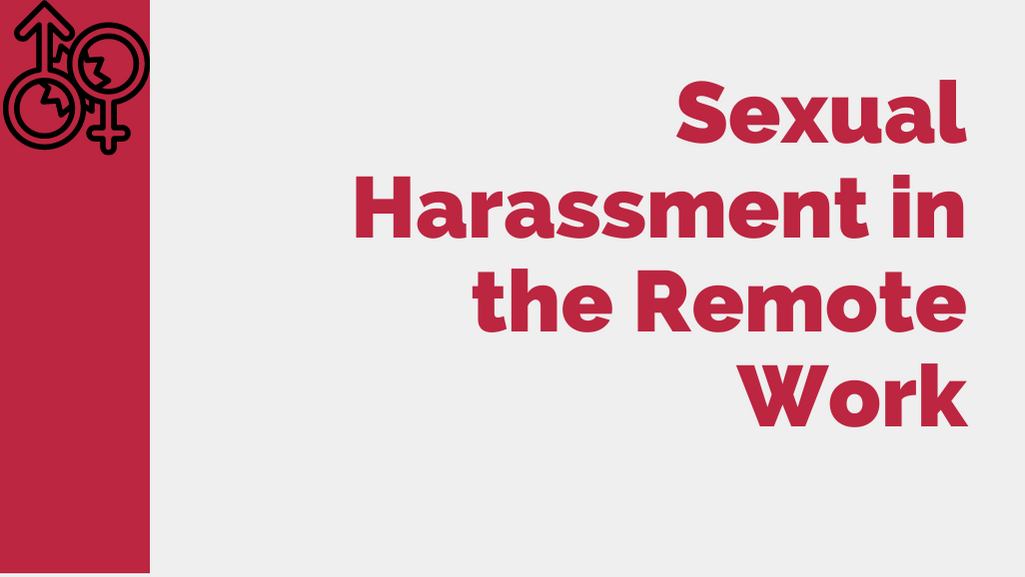Investigating Sexual Harassment In The Remote Work Space
Sexual harassment in remote work is a critical issue that affects individuals in various professional settings, including remote work environments. As technology continues to evolve, remote work has become increasingly popular, offering flexibility and convenience. However, it also presents unique challenges when it comes to addressing and preventing sexual harassment. This article aims to investigate the prevalence of sexual harassment in the remote work space, explore its impacts on individuals and organizations, and provide practical solutions to create a safe and inclusive remote work environment.
Table of Contents

Sexual Harassment in the Remote Work
Defining Sexual Harassment
Sexual harassment refers to any unwelcome conduct of a sexual nature that violates a person’s dignity, creates a hostile, intimidating, or offensive work environment, or adversely affects their employment conditions. It can occur through various means, including verbal, non-verbal, or written communication, visual displays, or physical actions.
The Impact of Sexual Harassment
Sexual harassment can have profound consequences for the victims, both personally and professionally. It creates an atmosphere of fear, discomfort, and inequality, making it challenging for employees to perform their duties optimally. The psychological and emotional toll can lead to increased stress, anxiety, and even depression. Moreover, victims may experience decreased job satisfaction, loss of self-esteem, and a reluctance to participate fully in their work environment.
Recognizing Signs of Sexual Harassment in the Remote Work Space
As remote work blurs the lines between professional and personal lives, it is crucial to identify the signs of sexual harassment, even in virtual settings. Some common signs include:
1. Unwanted advances or comments:
This can include inappropriate jokes, sexual innuendos, or explicit language directed at an individual.
2. Display of explicit or suggestive content:
Sharing explicit images, videos, or links without consent is a form of sexual harassment.
3. Cyberstalking or online harassment:
Persistent online monitoring, unwanted messages, or attempts to coerce an individual through digital means are all forms of harassment.
4. Discrimination based on gender:
Treating individuals differently due to their gender, such as excluding them from discussions or opportunities, is a form of sexual harassment.
Preventing and Addressing Sexual Harassment
Creating a safe and inclusive remote work environment requires a proactive approach from both organizations and individuals. Here are some key steps to prevent and address sexual harassment effectively:
1. Establish clear policies and guidelines:
Organizations should develop comprehensive policies that clearly define sexual harassment, outline the reporting process, and emphasize zero tolerance for such behavior. These policies should be communicated regularly to all employees.
2. Provide regular training and education:
Offering training sessions on sexual harassment awareness and prevention can help employees understand what constitutes harassment and how to recognize and report it. Training should also emphasize bystander intervention and the importance of supporting victims.
3. Foster a culture of respect and accountability:
Organizations must foster a workplace culture that promotes respect, equality, and accountability. This can be achieved through promoting open communication, addressing complaints promptly and impartially, and holding perpetrators accountable for their actions.
4. Encourage reporting and provide support:
Creating a safe reporting mechanism and ensuring confidentiality are crucial for individuals to feel comfortable coming forward. Organizations should provide victims support services, such as counseling or legal assistance, throughout the reporting and investigation process.
The Impact of Sexual Harassment in the Remote Work Space
- Emotional Distress and Psychological Effects: Sexual harassment can cause significant emotional distress for the individuals targeted. It can lead to feelings of fear, humiliation, anxiety, and depression. In a remote work setting, where individuals may already feel isolated, the impact of harassment can be even more detrimental to their mental health and overall well-being.
- Workplace Productivity and Performance: When individuals experience sexual harassment, their ability to focus and perform at work can be severely affected. The stress and anxiety caused by harassment can lead to decreased productivity, absenteeism, and a decline in the quality of work. This not only impacts the individuals directly involved but also has implications for the overall productivity and success of the organization.
- Workplace Morale and Employee Retention: Sexual harassment creates a toxic work environment that erodes trust and undermines employee morale. In a remote work setting, where face-to-face interactions are limited, maintaining a positive and inclusive work culture becomes even more challenging. Organizations that fail to address and prevent sexual harassment risk losing valuable employees and damaging their reputation.
- Legal and Financial Consequences: Sexual harassment in the remote work space can expose organizations to legal liabilities and financial consequences. If an employer fails to address reports of harassment or neglects to implement adequate policies and training, they may be held legally responsible for the actions of their employees. Legal battles can be costly and can tarnish the organization’s reputation in the long run.
Challenges of Investigating Sexual Harassment in the Remote Work Space
Investigating sexual harassment cases in the remote workspace presents unique challenges compared to traditional office settings. The lack of physical proximity and face-to-face interactions can make it difficult to identify and document instances of harassment.
Additionally, the absence of immediate supervisors or colleagues in the same physical space can create an environment where victims feel isolated and are reluctant to report incidents. These factors contribute to a heightened need for effective strategies to address and resolve allegations of sexual harassment in remote work environments.
Common Strategies for Employers
When addressing sexual harassment in the remote workspace, employers can adopt several strategies to create a safe and inclusive work environment. Here are four key strategies to consider: If you’re an employer seeking to tackle sexual harassment in the remote workspace, implementing effective strategies is crucial. By following these four essential tactics, you can create a secure and inclusive work environment that prioritizes the well-being of your employees:
-
Enhance Communication Channels
Building a strong communication foundation is pivotal in preventing and addressing sexual harassment. Ensure your employees have accessible and transparent communication channels where they feel comfortable reporting any incidents or concerns they may have.
To foster a culture of accountability and trust, consistently remind your employees about your organization’s anti-harassment policies, procedures, and their rights and responsibilities. Consider conducting training sessions or workshops to educate your workforce about sexual harassment, its impact, and effective prevention strategies.
-
Maintain Updated Policies and Procedures
To effectively combat sexual harassment, it’s essential to have comprehensive and up-to-date policies and procedures in place. These policies should clearly define sexual harassment, outline the reporting process, and specify the steps taken to investigate and address complaints. Regularly review and update your policies to align with the evolving nature of remote work and current legal requirements.
-
Establish Clear Work-Life Boundaries
Remote work can blur the lines between personal and professional life, making it crucial to emphasize the importance of maintaining a healthy work-life balance. Encourage your employees to set clear boundaries by defining specific working hours, taking regular breaks, and disconnecting after work. By doing so, you not only reduce the risk of harassment but also help alleviate the potential for burnout.
-
Lead by Example
Leaders within your organization significantly influence setting the tone and expectations for appropriate behavior. Demonstrating respectful and inclusive conduct in all employee interactions can establish a positive example for others to follow.
When leaders prioritize creating a safe and respectful work environment, it sets a standard that all employees can emulate. Promote a culture of respect and zero tolerance for harassment, empowering your workforce to report incidents without fear of retaliation. By fostering such an atmosphere, you encourage open dialogue and ensure the well-being of your employees.
Implement these strategies to proactively address sexual harassment in the remote workspace and create an environment that supports the professional growth and safety of your employees.
Employment Lawyer Can Help
Navigating the complexities of investigating sexual harassment cases in a remote work-space can be challenging for employers. Seeking guidance from a top Toronto employment lawyer can provide invaluable assistance in understanding legal obligations, conducting impartial investigations, and ensuring compliance with applicable laws and regulations. Lawyers can guide employers through the entire process, from prevention and training to resolution and, if necessary, litigation.
Addressing sexual harassment in the remote workspace requires proactive measures from employers. However, many other challenges are associated with remote work, including establishing clear policies and fostering open communication. By seeking the guidance of an experienced employment lawyer, organizations can create a safe and respectful environment for their remote workforce.
Hello, I’m Cansu, a professional dedicated to creating Excel tutorials, specifically catering to the needs of B2B professionals. With a passion for data analysis and a deep understanding of Microsoft Excel, I have built a reputation for providing comprehensive and user-friendly tutorials that empower businesses to harness the full potential of this powerful software.
I have always been fascinated by the intricate world of numbers and the ability of Excel to transform raw data into meaningful insights. Throughout my career, I have honed my data manipulation, visualization, and automation skills, enabling me to streamline complex processes and drive efficiency in various industries.
As a B2B specialist, I recognize the unique challenges that professionals face when managing and analyzing large volumes of data. With this understanding, I create tutorials tailored to businesses’ specific needs, offering practical solutions to enhance productivity, improve decision-making, and optimize workflows.
My tutorials cover various topics, including advanced formulas and functions, data modeling, pivot tables, macros, and data visualization techniques. I strive to explain complex concepts in a clear and accessible manner, ensuring that even those with limited Excel experience can grasp the concepts and apply them effectively in their work.
In addition to my tutorial work, I actively engage with the Excel community through workshops, webinars, and online forums. I believe in the power of knowledge sharing and collaborative learning, and I am committed to helping professionals unlock their full potential by mastering Excel.
With a strong track record of success and a growing community of satisfied learners, I continue to expand my repertoire of Excel tutorials, keeping up with the latest advancements and features in the software. I aim to empower businesses with the skills and tools they need to thrive in today’s data-driven world.
Suppose you are a B2B professional looking to enhance your Excel skills or a business seeking to improve data management practices. In that case, I invite you to join me on this journey of exploration and mastery. Let’s unlock the true potential of Excel together!
https://www.linkedin.com/in/cansuaydinim/










